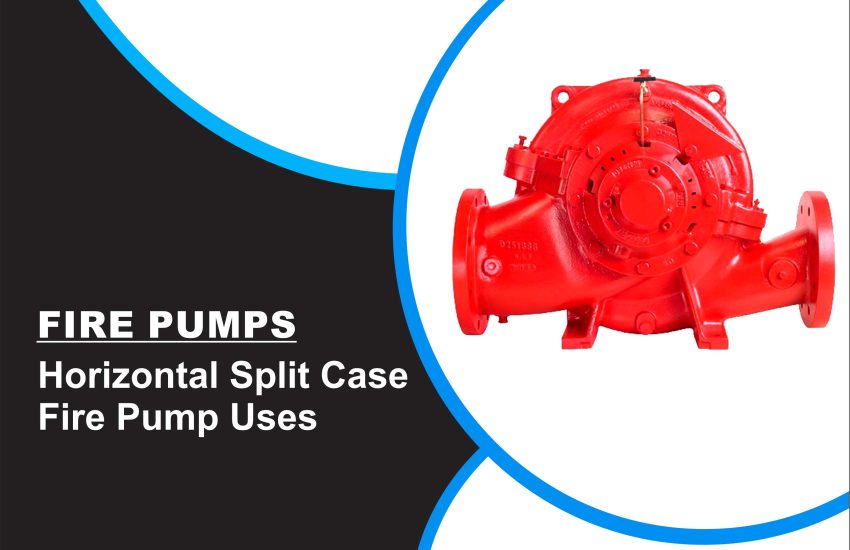Horizontal Split Case Fire Pump Uses. pumps play a vital role in fire protection systems across commercial, industrial, and municipal settings. These pumps use a between-the-bearings design, meaning the impeller is supported by bearings on both sides. As a result, the impeller receives better support, allowing it to rotate more efficiently under heavy stress. Additionally, the suction and discharge nozzles are located on opposite sides in the bottom half of the casing, while the shaft is positioned slightly above the flanges. Thanks to this layout, the pump handles a wide range of flows with reduced thrust load on the shaft.
What Are Horizontal Split Case Fire Pumps?
Horizontal split case fire pumps feature a split-casing construction, which simplifies maintenance. Unlike vertical pumps or end-suction designs, these pumps allow easy access to internal components without disturbing the piping or motor. Their rugged yet straightforward structure makes them highly reliable for high-flow fire protection systems.
Key Advantages of Horizontal Split Case Fire Pumps
1. Wide Flow and Pressure Range
HSC pumps come in a broad variety of sizes. Consequently, they are capable of handling low to very high flows and heads, making them suitable for diverse fire protection needs.
2. Simple Maintenance and Inspection
One major advantage is the removability of the upper casing, which allows technicians to inspect or service the rotor without detaching the piping or driver. Therefore, maintenance is quicker and more cost-effective.
3. Smaller Footprint
Compared to frame-mounted pumps of the same capacity, HSC fire pumps usually require less installation space, which is beneficial in compact fire pump rooms.
4. High Hydraulic Efficiency
The dual-eye (dual-suction) impeller design improves efficiency and reduces the required net positive suction head (NPSHR). Moreover, it minimizes axial thrust, which contributes to longer equipment life.
5. Low Shaft Deflection
Because the shaft is short, it experiences minimal deflection. This leads to more stable operation and lower risk of misalignment.
6. Dual Volute Design
Many HSC pumps feature a dual volute casing, which balances radial forces. Consequently, this design enhances bearing life and reduces vibration.
7. Multiple Drive Options
These pumps are commonly available with either electric motors or diesel engines, which offers flexibility in meeting code requirements, such as those outlined in NFPA 20.
8. Pre-Piping Advantages
Unique to some models, such as Armstrong pumps, the 15-degree angled casing split allows the suction and discharge flanges to align. As a result, piping installation becomes simpler and more accurate.
Common Applications of HSC Fire Pumps
- High-rise buildings
- Industrial facilities
- Municipal water systems
- Commercial complexes
- Power generation plants
- Facilities requiring diesel-driven fire protection systems
Because of their high reliability and performance, these pumps are frequently installed in systems that demand continuous readiness and rapid water delivery.
Disadvantages of Horizontal Split Case Fire Pumps
Although HSC fire pumps offer many benefits, they are not without limitations. It’s important to consider the following drawbacks when specifying or installing them.
1. Suction Piping Sensitivity
Improper suction piping—especially horizontal elbows—can lead to uneven fluid flow. This creates imbalanced pressures on the impeller, which reduces seal and bearing life.
2. Limited Temperature Range
Due to the uneven mass of the upper and lower casing halves, they expand at different rates during temperature changes. This can cause misalignment and reduce bearing and seal performance. Therefore, most manufacturers recommend keeping operating temperatures below 400°F.
3. Higher Initial and Maintenance Costs
Since the pump contains two stuffing boxes, it requires two sets of mechanical seals or packing. This increases the total cost of ownership.
4. Seal Compatibility Issues
Some models limit stuffing box dimensions, which restricts the use of standard or budget-friendly seals. This can further elevate operational costs.
5. Sensitivity to Pipe Strain
While model-specific, some HSC pumps are more sensitive to pipe strain than vertical or end-suction designs. Poor installation can lead to shaft misalignment and premature wear.
6. Suction Eye Area Limitation
Although the dual-suction impeller reduces NPSHR, the shaft running through it reduces the effective eye area. As a result, this design may struggle with suction-specific speed factors and off-BEP (Best Efficiency Point) operation.
7. Clearance and Alignment Challenges
Performance issues can also arise from uneven or excessive wear in ring clearances. Disparities between clearances on either side of the impeller can cause impeller damage, imbalance, or thrust-related problems.
Conclusion
Horizontal Split Case Fire Pump Uses deliver exceptional reliability, high flow capacity, and service-friendly design, making them a preferred choice for fire protection systems worldwide. While there are some limitations—particularly around suction piping, temperature constraints, and maintenance costs—many of these can be addressed through proper installation and routine maintenance.


